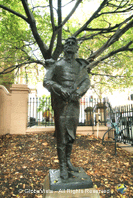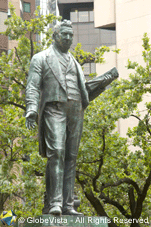
In a previous chapter, I alluded to Governor Macquarie‘s fondness for stone walls. No building was complete in the “building Governor’s” eyes until it was properly walled about. When he completed the barrack buildings to his satisfaction, the Governor must have contemplated the stretch of George street from where the Bank of Australia afterwards stood to Barrack street with particular satisfaction, for was it not one of the boundaries of his barracks, and, therefore, in need of a wall? So, like Balbus, he built a wall —a noble wall ten feet high, and for some thirty years that stretch of wall was a feature of Sydney.
It extended, not alone on this front, but went right round the barracks, i.e., up Barrack Street to Clarence Street, along that street, to a little north of Margaret Street, and on to the point of commencement, Macquarie gave as his reason for the height that “the great object of this wall is to restrain as much as possible the intercourse between the military and the inhabitants of the town.”
The Old Barracks
Inside the wall were barracks for officers and men, storehouses, and parade and exercise grounds. The main row of barracks stood between Clarence and York streets, the men’s in the centre, with the officers’ to right and left, and between the latter street and George street was the parade ground. The main entrance was in George street, and a broad gravel path led straight up to the barracks. It was bordered on either side by grass plots, and these same plots were the cause of making one colonel in charge very unpopular in Sydney.
Colonel Despard was that officer, and it may have been a hereditary instinct that made him unpleasant, for he was the son of that Captain Despard who with others conspired to take the life of George III. The people of Sydney had what they considered an immemorial right to enter, during the day time, the main gate in George street, and to walk across the grass to a gate on the right as a short cut to Fort street, and on the left to York street. Colonel Despard decided to stop this privilege and posted sentries to warn people off the grass. Indignation burst forth in letters to the “Sydney Morning Herald,’ and in doggerel song, the refrain of one of which ran :—-
Get off the grass, get off the grass, Said Corporal Desparado.
To add to his load of iniquity the colonel ordered that early morning bugle practice should be held outside the barracks on Flagstaff Hill. Naturally, the dwellers in the locality, whose early morning slumbers were so unduly interrupted, objected to this innovation. One of them burst into song, and in the “Herald” of January 31st, 1845, you may find “The Morning Serenading Corps, or Music Before Daylight, a lament from the miserable and unhappy residents in Fort street and its immediate vicinity.” One verse ran:—
All vanished now thy glory,
Thy star is on the wane;
The 99th in story
Shall never shine again.
Their Colonel loathes the martial notes
On which each other colonel dotes.

When the Paddington barracks were completed, in 1847, the troops were moved out of the old barracks, and between 1850 and 1853 the area was cut up and sold, with the exception of the Wynyard Reserve, which remains as a memorial of the barrack-square.
Within this reserve is a statue of John Dunmore Lang, and I cannot refrain from recording a little incident round this statue told to me by that sweet old lady Mrs. F. Ranken. Mrs. Lang, the Doctor’s widow, told her that after much pressure she consented to unveil this statue. “I pulled the flag,” she said, “but I didn’t look at the statue. At night it was wet and cold, and I felt as if I wanted to go out and bring it in alongside the fire.”
